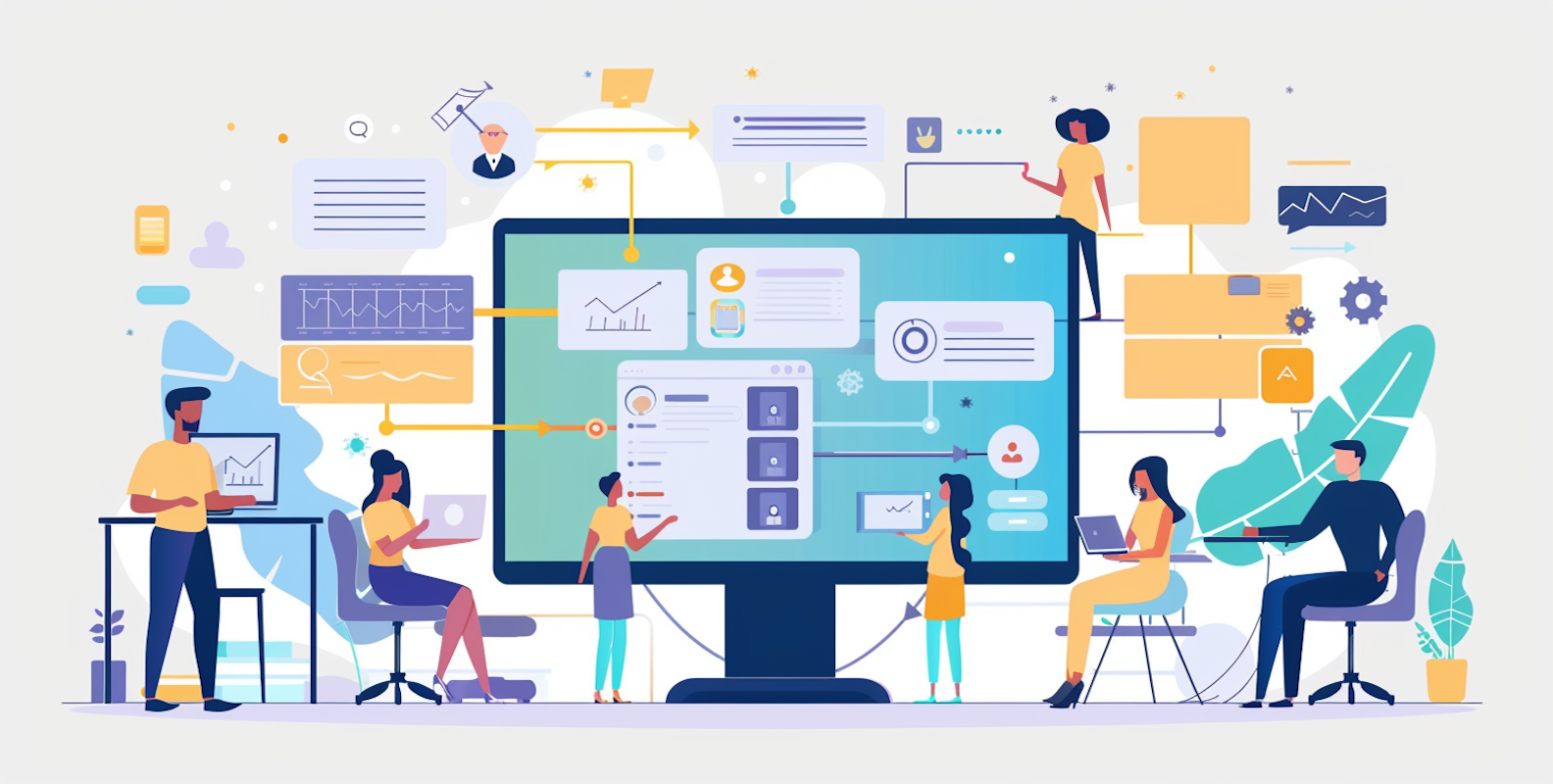Canva API: Automate Your Design Processes Efficiently
Discover the benefits of integrating the Canva API to streamline your design tasks and enhance automation in your business processes.

The Canva API opens up exciting possibilities for businesses looking to integrate powerful design capabilities directly into their workflow. By connecting Canva's creative platform with your existing business applications, you can transform how design assets are created, managed, and scaled across your organization.
Understanding the Canva API
At its core, the Canva API (Application Programming Interface) provides programmatic access to Canva's extensive design features and templates. This technology bridge lets your applications communicate directly with Canva, allowing you to automatically generate designs, update content, and streamline workflows without constant manual intervention.
For businesses drowning in repetitive design tasks, the API offers a welcome lifeline. Marketing teams can automate social media graphics, sales departments can generate personalized materials on demand, and IT teams can integrate design capabilities into existing business systems. The end result? Hours of manual work transformed into seamless, automated processes.
Key Benefits of Implementing the Canva API
When integrated thoughtfully, the Canva API delivers substantial value across multiple business functions. Here's what makes it particularly valuable:
Automation of Repetitive Design Tasks
Routine design work often follows predictable patterns – updating dates, swapping images, or adjusting text while maintaining brand consistency. The Canva API excels at capturing these patterns and executing them automatically through simple API calls, freeing your creative team to focus on higher-value work.
Data-Driven Personalization
By connecting your business data with Canva templates, you can dynamically customize designs for individual recipients. This means your customer communications, marketing materials, and internal documents can automatically reflect relevant information – names, preferences, purchase history, or custom offers – without manual design intervention.
Workflow Integration
The real power comes from connecting Canva's design capabilities with your existing business systems. Whether it's your CRM triggering welcome materials for new customers, your product database generating updated catalogs, or your event platform creating personalized certificates, the API eliminates disjointed processes and manual handoffs.
Scalability Without Quality Compromise
Need to produce hundreds or thousands of variations of a design? Manual approaches quickly become unsustainable, but the Canva API handles volume effortlessly. This maintains consistent quality while dramatically reducing production time – particularly valuable for large campaigns or personalized customer communications.
Real-World Applications Across Departments
The versatility of the Canva API means it delivers value across multiple business functions:
Marketing Applications
Marketing teams face constant pressure to produce fresh, engaging visual content across multiple channels. The Canva API helps by:
- Automatically generating social media graphics with current promotions, seasonal messaging, or localized content
- Creating personalized email headers and banners that match campaign themes and recipient segments. For teams seeking an even more tailored approach for email visuals, solutions like an email builder can help create professional email templates with ease.
- Producing customized digital ads with dynamically updated offers and messaging
- Refreshing website graphics based on inventory, promotions, or user behavior
Customer Experience Enhancement
Modern customers expect personalized experiences. The Canva API enables:
- Custom welcome kits with personalized graphics based on customer preferences or history
- Tailored product guides that highlight features relevant to specific customer segments
- Personalized thank-you graphics or certificates after purchases or milestones
- Branded order confirmations and shipping notifications with dynamic content
Internal Communications & HR
Even internal documents benefit from automation and personalization:
- Employee recognition certificates generated automatically based on achievement data. For organizations with extensive documentation or certificate needs, specialized PDF builder tools can automate the creation of high-quality, brand-consistent PDFs at scale.
- Onboarding materials customized for specific departments or roles
- Company announcements with dynamic content for different teams or locations
- Training materials with personalized elements based on employee profiles
Technical Implementation: How Integration Works
For developers and technical teams, implementing the Canva API involves several straightforward steps:
- Obtain API Access: Register as a Canva developer to receive your API credentials and access the developer portal.
- Review Documentation: Familiarize yourself with the API endpoints, authentication requirements, and available operations.
- Plan Your Integration Architecture: Determine how the API will fit into your existing systems, including:
- Which applications will initiate design requests
- How template data will be managed and populated
- Where completed designs will be stored or deployed
- What error handling and monitoring will be implemented
- Develop Your Integration: Build the necessary code to:
- Authenticate securely with Canva
- Send appropriately formatted requests
- Handle responses and exported designs
- Manage errors gracefully
- Test Thoroughly: Verify your integration works correctly across different scenarios, data inputs, and edge cases.
- Deploy and Monitor: Launch your integration with appropriate monitoring to track usage, performance, and any issues.
Most Canva API implementations use RESTful HTTP requests, making them compatible with virtually any modern programming language or development environment. The API supports standard authentication methods, making secure integration straightforward for development teams.
Security Considerations When Using the Canva API

As with any external API integration, security should be a primary consideration. Key practices include:
Secure Credential Management
Your Canva API key provides access to your account and templates. Treat it with the same care as any sensitive credential:
- Store keys in secure environment variables, never in code repositories
- Use different keys for development, staging, and production environments
- Implement proper key rotation procedures
- Restrict key access to only necessary personnel and services
Data Transfer Protection
When sending data to populate templates, ensure:
- All communications use secure, encrypted connections
- Personal or sensitive information is handled according to your privacy policies
- Any data validation happens before submission to prevent injection attacks
- Appropriate content filtering prevents misuse of dynamic content capabilities
Access Control Implementation
For enterprise implementations:
- Use fine-grained permissions to limit template access to appropriate users
- Implement audit trails for design creation and modification
- Consider OAuth implementation for delegated user access when appropriate
- Regularly review access patterns for unexpected behavior
Maximizing Value: Best Practices for Canva API Implementation
To get the most from your Canva API investment, consider these strategic approaches:
Start with High-Impact, Low-Complexity Use Cases
Begin your implementation with processes that:
- Consume significant manual design time
- Follow predictable, repeatable patterns
- Deliver clear business value
- Have well-defined data inputs
This approach builds confidence and demonstrates ROI quickly before tackling more complex scenarios.
Implement Thoughtful Template Management
Success with the Canva API depends largely on well-designed templates:
- Create templates specifically for API use with clear variable placement
- Document template structure and requirements thoroughly
- Implement version control for templates
- Test templates with varied data inputs before deployment
Build Monitoring and Maintenance Processes
Sustainable API implementation requires oversight:
- Track API usage against limits
- Monitor error rates and response times
- Establish alerting for critical failures
- Create regular maintenance schedules for templates and integration code
Consider Hybrid Approaches for Complex Documents
For sophisticated document needs, consider combining tools:
- Use Canva API for visual elements and layout
- Pair with document-specific APIs (like PDF generation tools) for complex forms or data-heavy reports
- Implement workflow automation to connect multiple specialized services
Canva API vs. Specialized Document Solutions
While the Canva API excels at design automation, some document scenarios benefit from purpose-built solutions. Consider these distinctions when planning your implementation:
Visual Design-Focused Projects
The Canva API shines brightest for visually rich content like:
- Social media graphics and digital marketing assets
- Presentations and infographics
- Certificates and recognition materials
- Visual-first communications
Complex Document Requirements
For document-heavy workflows, specialized solutions often provide advantages for:
- Multi-page reports with complex data tables
- Forms with interactive elements
- Documents requiring digital signatures or compliance features
- High-volume transactional documents (invoices, statements, contracts)
Many organizations implement both types of solutions, using each for its strengths while connecting them through workflow automation platforms. If you need to automate both email and PDF workflows, an email API can offer robust solutions for integrating messaging and documentation at scale.
Common Implementation Questions
When evaluating or implementing the Canva API, teams frequently ask:
What are the cost considerations?
Pricing depends on your usage levels and specific Canva plan. Review the current pricing structure on Canva's developer portal, considering both API access costs and any additional template or feature requirements. For a clear understanding of solution costs, consider visiting Expressa's pricing page for transparent, tiered pricing on design workflow automation.
How much development expertise is required?
Basic implementations require fundamental REST API knowledge and experience with your existing systems. More sophisticated integrations benefit from developers experienced in authentication, error handling, and scalable design.
How can we test before full implementation?
Canva provides sandbox environments for testing integrations before production deployment. Develop a proof-of-concept with a small set of templates and test thoroughly across various scenarios before scaling up.
What happens if Canva changes their API?
Like all API providers, Canva follows standard versioning practices and provides advance notice of significant changes. Follow their developer communications channels and build version awareness into your implementation.
Building Your Canva API Strategy
To successfully implement the Canva API in your organization:
- Identify Key Stakeholders: Include representatives from design, marketing, IT, and business process teams.
- Audit Current Design Processes: Document which current workflows could benefit from automation, noting volume, complexity, and business impact.
- Prioritize Use Cases: Rank potential implementations based on business value, technical complexity, and resource requirements.
- Create an Implementation Roadmap: Develop a phased approach starting with high-value, lower-complexity scenarios.
- Measure Success: Establish clear metrics for success, such as time saved, increased output, or improved consistency.
Conclusion: Transforming Design Workflows with Strategic Automation
The Canva API represents a significant opportunity to reimagine how design work happens in your organization. By connecting Canva's powerful design platform directly to your business systems, you can automate routine tasks, personalize content at scale, and free creative teams to focus on high-value work.
For organizations struggling with design bottlenecks, inconsistent branding, or the inability to scale visual content, the Canva API offers a compelling solution. The key to success lies in thoughtful implementation, starting with clear business objectives, choosing the right use cases, and building sustainable processes around your integration.
Whether you're looking to streamline marketing production, enhance customer communications, or improve internal document workflows, the Canva API provides a flexible foundation for design automation that grows with your needs. If you're considering broader design and document automation, Expressa can help support your digital transformation with robust, integrated tools.
Frequently Asked Questions
Is the Canva API suitable for small businesses or primarily for enterprises?
The API offers value for organizations of all sizes. Small businesses often benefit from automating their limited design resources, while enterprises appreciate the scalability for large campaigns.
What technical skills are needed to implement the Canva API?
Basic implementation requires familiarity with REST APIs and your existing systems. More complex integrations benefit from developers experienced in authentication, error handling, and data management.
How does the Canva API handle template versioning?
The API includes capabilities to manage template versions, allowing you to update designs while maintaining existing automations. This is particularly valuable for maintaining brand consistency during visual identity updates.
Can we restrict what templates certain users or systems can access?
Yes, Canva's enterprise offerings include role-based permissions that extend to API access, allowing granular control over which templates and brand assets are available to different users or systems.
How does licensing work for designs created through the API?
Designs created through the API follow the same licensing terms as your Canva subscription. Ensure your usage complies with these terms, particularly for commercial applications.
What support resources are available for implementation challenges?
Canva provides extensive developer documentation, sample code, and support forums. Enterprise customers typically receive additional implementation assistance based on their service level agreements.


